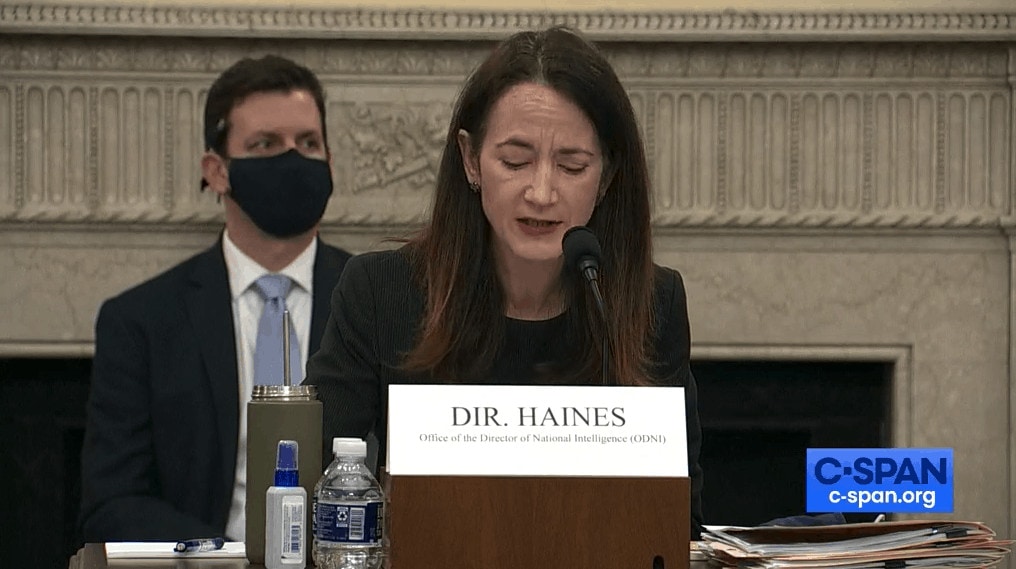2021 ODNI Annual Threat Assessment includes “domestic violent extremists” for first time
America’s intelligence community has issued its annual threat assessment, presenting its findings to the Senate Select Committee on Intelligence at a hearing on April 14.
The world-wide threat assessment examines the top perceived threats from foreign powers, organizations and persons. It typically emphasizes conventional adversaries such as Russia, China, Iran, and North Korea, along with terrorist groups such as ISIS and al-Qaeda.
For the first time, the intelligence community assessment addressed perceived “domestic” threats within the assessment, following a demand by the Biden administration. The 2019 Office of the Director of National Intelligence (ODNI) report had previously contained information regarding European-based “violent ethno-supremacist and ultranationalist groups” under the terrorism section, but there was no reference to U.S. domestic actors.
Confusingly, the 2021 assessment includes “domestic violent extremists” under the sub-heading of “global terrorism.” Specific international terrorist organizations, including Hezbollah, al-Qaeda, and ISIS are identified. Yet no specific domestic terror organizations or threats are named. Instead, the assessment reiterates categories defined by the ODNI in their March 1 assessment, “Domestic Violent Extremism Poses Heightened Threat in 2021.”
Given that the Annual Threat Assessment has a global focus, there is no new information about “domestic” threats, and the information was included at the behest of the Biden administration, this appears to be an example of politicized intelligence.
As noted at the time, the March 2021 Domestic Violent Extremism assessment used disturbingly politicized threat categories and definitions. It appeared to deliberately undermine the significance of any domestic threats other than those posed by white supremacist or “right-wing” extremists, which the assessment termed “racially or ethnically motivated” and “militia” violent extremists.
Despite no new details, organization names or details, the ODNI repeats the March Domestic Violent Extremism assessment claim that these threats represent the largest transnational network of extremists. As before, the ODNI offers little evidence to support that claim.
While some level of transnational communication is likely, in many cases the resulting links are less than impressive. As David Hines notes regarding the transnational ties of the white supremacist group “Atomwaffen” in his Center paper “Towards a Useful Taxonomy of White Supremacist Attitudes”:
Internationalization of the movement online failed to draw capable leadership or followers. In April 2020, Estonian police announced they had located “Commander,” the enigmatic leader of Feuerkrieg Division. He was a thirteen-year-old boy (Gonzalez 2020).
Without reference to specific organizations and case studies, it is difficult to know how seriously to take the ODNI’s analytical rigor regarding these networks.
In comparison, as noted in recent Senate testimony, Antifa and related anarchist and communist groups possesses a broad and effective international network and are able to raise money and support across international borders.
In January 2021, the FBI arrested Daniel Alan Baker, an Antifa supporter who had previously fought abroad in Syria. Baker had allegedly publicly discussed plans to open fire on Trump supporters and police officers at the Florida State capitol in Tallahassee. Trump administration efforts to investigate international Antifa ties and particularly ties to armed groups in Northern Syria, were broadly dismissed in leaks to the press.
Antifa networks have engaged in significant attacks in France and Germany. A 2020 German report highlighted risks from “left-wing” antifa networks which are increasingly willing to perpetrate violence. In 2010 NBC news reported on the growing rise of international anarchist groups based in Italy and Greece which sought to coordinate “a revolutionary war” across Europe.
In 2016, under the Obama administration the intelligence community was more openly concerned with international anarchist networks, and filed a report highlighting the degree of international cooperation. J. Michael Waller noted in his chapter for the Center’s recent book “Unmasking Antifa: Five Perspectives on a Growing Threat:”
In late 2015 or early 2016, the FBI and the Department of Homeland Security (DHS) began investigating Antifa for links to foreign violent extremist groups. “The purpose of the investigation, according to the April 2016 assessment,” Politico reported, was “to determine whether the U.S.-based anarchists might start committing terrorist bombings like their counterparts in ‘foreign anarchist extremist movements’ in Greece, Italy and Mexico, possibly at the Republican and Democratic conventions that summer.”
There is no mention of Antifa or anarchist extremists in the 2021 ODNI Threat Assessment.
The ODNI’s decision to utilize the intelligence community to politicize domestic threats is concerning. Given the numerous worldwide threats which the ODNI mentions in their report, including Russia, China, Iran, North Korea, global jihadism and transnational criminal syndicates, this foray into questions of domestic ideologies is unwelcome, and risks discrediting the work of the intelligence community on other subjects.
- Anarchist orchestrated “economic blockade” is about more than Palestine - April 16, 2024
- Return of the sheriff - February 27, 2024
- US over-reliance on electronic intelligence risks deceptive consequences: Shideler - February 7, 2024

